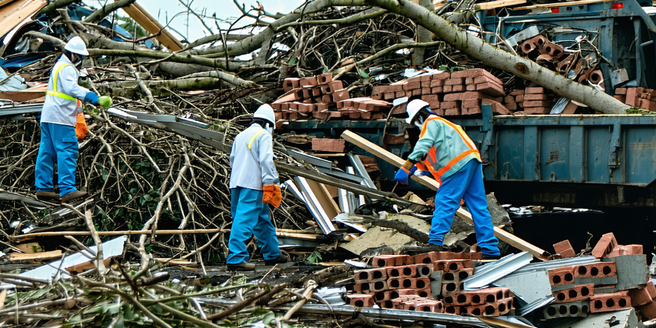
Understanding the Importance of Debris Management
Debris management is crucial in disaster response as it ensures public safety, health, and swift recovery operations. Debris, from natural disasters like earthquakes and hurricanes, can obstruct roads, hinder emergency services, and pose health risks. Proper management reduces these hazards by prioritizing clearance, efficient disposal, and recycling. It involves planning and evaluating the debris type, predicting quantities, and allocating resources effectively. Coordination among local, state, and federal agencies is essential to optimize debris management strategies. Understanding its importance enables communities to recover faster, minimizes environmental impacts, and facilitates safer reconstruction efforts. Effective debris management is not just about removing waste but about safeguarding lives and restoring normalcy.
Evaluating the Types of Debris in Disaster Zones
Disaster zones produce various debris types, each requiring unique handling and disposal strategies. Common categories include vegetation, construction materials, hazardous waste, and personal property debris. Evaluating the debris type helps in prioritizing removal efforts, reducing health risks, and allocating appropriate resources. This assessment is crucial for effective disaster recovery operations. Understanding the mix of debris allows specialized teams to use suitable equipment and techniques for efficient clearing. It’s essential to assess thoroughly to determine potential recycling opportunities or hazardous material containment. Proper evaluation is key to developing a targeted and effective debris management plan, ensuring safety and optimizing resource utilization.
Safety Precautions for Debris Clearing Operations
Safety is paramount in debris clearing operations to protect workers and ensure an incident-free environment. Proper gear, including helmets, gloves, and boots, is essential to shield against physical injuries. Teams should undergo safety briefings to understand hazards present in different debris types. Maintaining a clutter-free workspace minimizes trip hazards and enhances operator efficiency with heavy machinery. Providing first aid training and having kits readily accessible can be lifesaving. Involving safety officers in planning can help foresee and mitigate risks, ensuring operations proceed smoothly. Adhering strictly to safety protocols helps prevent accidents, safeguarding both team members and the community.
Essential Tools and Equipment for Efficient Clearing
Efficient debris clearing requires a range of specialized tools and equipment. Key tools include chainsaws and axes for clearing fallen trees and vegetation. Excavators and loaders help in moving heavy debris like concrete and metal. Trucks and dumpsters are essential for transporting materials to disposal sites. Personal protective equipment, such as gloves, helmets, and masks, ensure the safety of workers handling hazardous debris. Communication devices are also vital for coordinating team efforts in scattered zones. Access to these tools and understanding their application is crucial to ensuring the debris clearing process is swift, thorough, and safe.
Step-by-Step Guide to Implementing a Clearing Protocol
Implementing a debris clearing protocol requires structural planning and iterative action. Start with a thorough assessment to prioritize high-risk zones. Mobilize trained teams equipped with necessary tools. Conduct safety briefings and define communication channels. Begin clearing from critical access paths, gradually expanding to less urgent areas. Evaluate and segregate debris to identify recyclable materials. Monitor progress regularly, making adjustments for efficiency. Provide rest periods to maintain team effectiveness. By following structured steps, the clearing protocol ensures systematic handling of debris, optimizing resources, and maximizing safety during operations. This organized approach aids in a swift, effective recovery.
Training and Coordination of Debris Clearing Teams
Training and coordination are vital for effective debris clearing efforts. Teams must be skilled in handling different debris types and operate machinery safely. Regular exercises and drills simulate real conditions, enhancing response readiness. To further enhance their skills, team members are often encouraged to attend specialized workshops and certification programs. Proper coordination ensures teams work in harmony, covering divided zones efficiently without overlap. Clear hierarchies and communication systems are necessary for keeping team members informed and aligned. This structured training and coordination framework empowers teams to execute their tasks with precision and safety awareness. Comprehensive attention to these elements reduces the risk of injury and greatly improves clearing operations’ success.
